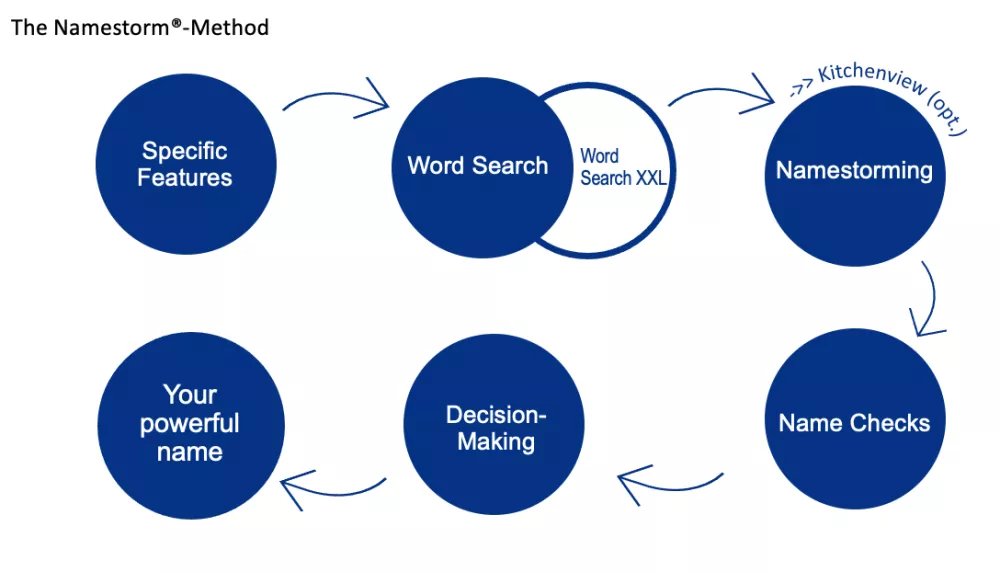The method for successful name development
The demands on professional name development are high. Despite all creativity, uniqueness and enthusiasm for great ideas, the name must also be usable and suitable for the offering in the long run.
Using ourNamestorm® Method we keep all aspects and challenges of the naming process in mind and guarantee the broadest range of creativity combined with meticulous scrutiny of the names we propose. How we proceed and the steps we follow are summarized below. You can read about it in more detail in our book "Strong Names - Developing Company and Product Names with the Namestorm Method":
Good names are essential success factors. Finding them, however, is anything but easy. The Namestorm® method shows which five steps are necessary for this:

Step 1: Work out the special features of the project
The most important rule for starting any name search is: forget all requirements, wishes, difficulties and previous attempts! The search for a name does not start with thoughts about the name itself but with the product or project to be named: What is unique about it? What distinguishes it from others? What do you want to emphasize? Which target group should get what added value from it?
A comprehensive briefing is essential to get into the topic and focus on the project's main features. Therefore, we always ask for the project's 3-5 most important characteristics. To learn even more about the "character" and gather fodder for naming, creative questions like:
- What three characteristics would the project have if it were a person?
- Which animal, plant, or movie would best embody the project? Which celebrity would fit the endeavor?
- The proposal has a superpower - what would it be?
Step 2: Increase word collection
As with other creative processes, the same is true here: The basis for good ideas is lots of ideas. The larger and more diverse the vocabulary, the more material we have for name development. The following approaches have proven successful:
Find as many words as possible that build on the Special Features from Step 1. Find synonyms and associations and take unusual paths. Find close, but above all, more distant word cognates. Creative methods such as Word writing, Wonder Pictures, or the flip-flop method help us to really extract all possible and impossible terms from the vocabulary.
Step 3: Turn words into names
The vocabulary provides the raw material from which concrete name ideas are formed. Here, too, the first step is to find as many ideas as possible in all potential "directions" for selection. Orientation is provided by the Big Five of the most common types of names, which we always keep in mind and prioritize depending on the nature of the project:
- Descriptive names that (still) identify the thing or function (e.g., Luckypage, SoundHound).
- Abbreviations, especially acronyms of speakable syllables (Haribo), make more resonant names than mere letters (IBM).
- Figurative names that follow metaphors or associations (Apple, Lime, Rockbird). An inspiring type of name you must get used to for your project. In return, you achieve attention and uniqueness.

- Artificial names, i.e., all newly created words that are not in the dictionary. They can be created by changing individual letters (Yuper) or look as if they were made entirely up (Zalando). That is where the range of possibilities is at its widest, as there are virtually no limits to the imagination. Despite all creative freedom, we have the pronunciation, sound and comprehensibility of the names in mind.
- Name names are (invented) proper names that convey a particular image (Steve Dogs, Frida Frisch) — an interesting way to create closeness and personal connection to the brand with the name.
Step 4: Name Checks
The most important question after creating many ideas is whether one can use the name at all, i.e., whether it is not already taken by somebody else. We conduct extensive preliminary research in the relevant classes and registers to exclude contradictions against the name as far as possible. To avoid losing sight of the costs, we start with the first list of ideas with a lower checking effort (identical check). The closer we get to the final name favorite, we increase this in a well-functioning sequence of creative and checking rounds. Due to the variety of existing ideas, we have several alternative candidates available if a name falls out during the research. The review does not replace legal advice.
Step 5: Decide
Deciding on a final name is more complex than one might think. Requirements are high, opinions often differ, and unusual names, in particular, are often met with spontaneous rejection. Our method provides decision-making aids and tools to achieve a result that suits everyone. In case of doubt, it means returning to the specific characteristics and using the most important ones as criteria: Should the name be more descriptive or imaginative? Is originality more important or seriousness? Trendy or reserved? We'll tell you in advance: So far, the decision has always worked out!
Conclusion: With the name development according to the Namestorm® method, we offer highly creative name ideas in a transparent and easily representable process with simultaneous meticulous pre-testing, which protects you from unpleasant surprises with the name.

